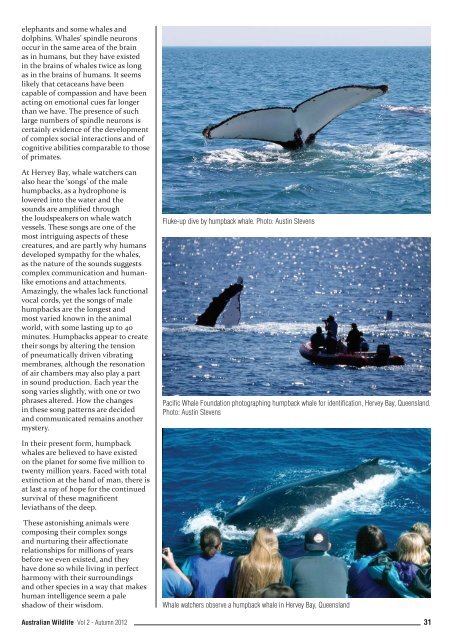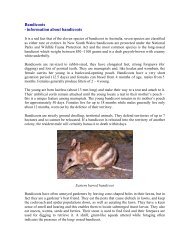Wildlife Preservation Autumn 2012.indd - Wildlife Protection Society ...
Wildlife Preservation Autumn 2012.indd - Wildlife Protection Society ...
Wildlife Preservation Autumn 2012.indd - Wildlife Protection Society ...
Create successful ePaper yourself
Turn your PDF publications into a flip-book with our unique Google optimized e-Paper software.
elephants and some whales and<br />
dolphins. Whales’ spindle neurons<br />
occur in the same area of the brain<br />
as in humans, but they have existed<br />
in the brains of whales twice as long<br />
as in the brains of humans. It seems<br />
likely that cetaceans have been<br />
capable of compassion and have been<br />
acting on emotional cues far longer<br />
than we have. The presence of such<br />
large numbers of spindle neurons is<br />
certainly evidence of the development<br />
of complex social interactions and of<br />
cognitive abilities comparable to those<br />
of primates.<br />
At Hervey Bay, whale watchers can<br />
also hear the ‘songs’ of the male<br />
humpbacks, as a hydrophone is<br />
lowered into the water and the<br />
sounds are ampli ed through<br />
the loudspeakers on whale watch<br />
vessels. These songs are one of the<br />
most intriguing aspects of these<br />
creatures, and are partly why humans<br />
developed sympathy for the whales,<br />
as the nature of the sounds suggests<br />
complex communication and humanlike<br />
emotions and attachments.<br />
Amazingly, the whales lack functional<br />
vocal cords, yet the songs of male<br />
humpbacks are the longest and<br />
most varied known in the animal<br />
world, with some lasting up to 40<br />
minutes. Humpbacks appear to create<br />
their songs by altering the tension<br />
of pneumatically driven vibrating<br />
membranes, although the resonation<br />
of air chambers may also play a part<br />
in sound production. Each year the<br />
song varies slightly, with one or two<br />
phrases altered. How the changes<br />
in these song patterns are decided<br />
and communicated remains another<br />
mystery.<br />
In their present form, humpback<br />
whales are believed to have existed<br />
on the planet for some ve million to<br />
twenty million years. Faced with total<br />
extinction at the hand of man, there is<br />
at last a ray of hope for the continued<br />
survival of these magni cent<br />
leviathans of the deep.<br />
These astonishing animals were<br />
composing their complex songs<br />
and nurturing their a ectionate<br />
relationships for millions of years<br />
before we even existed, and they<br />
have done so while living in perfect<br />
harmony with their surroundings<br />
and other species in a way that makes<br />
human intelligence seem a pale<br />
shadow of their wisdom.<br />
Australian <strong>Wildlife</strong> Vol 2 - <strong>Autumn</strong> 2012<br />
Fluke-up dive by humpback whale. Photo: Austin Stevens<br />
Pacific Whale Foundation photographing humpback whale for identification, Hervey Bay, Queensland.<br />
Photo: Austin Stevens<br />
Whale watchers observe a humpback whale in Hervey Bay, Queensland<br />
31





